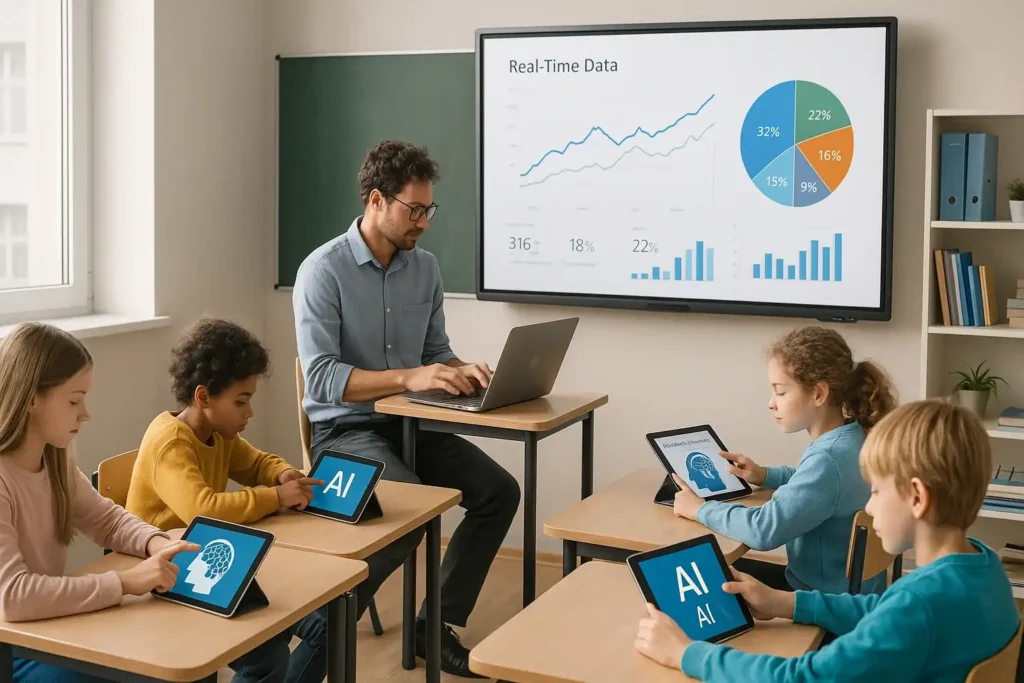The role of AI in education systems worldwide is growing every day. All around the world, countries are using Artificial Intelligence to improve the way students learn and how teachers teach. But how exactly is this happening? And how can we trust that these changes are really making a difference?
Let’s explore real, proven examples of how AI is being used in different education systems, in a clear and simple way—like a conversation with a friend. Whether you’re a teacher, a school principal, or just someone curious about this topic, this article is here to help.
What Is the Role of AI in Education Systems Worldwide?
AI, or Artificial Intelligence, is like a super helper. It can analyze data, learn from it, and suggest better ways to do things. In education, AI is being used to create smarter classrooms, help students learn at their own pace, and support teachers in their daily tasks.
Let’s now look at what this means in real-life schools across different countries.
Concrete Examples of AI in Education Around the World
United States: AI That Adapts to the Student
In the U.S., several schools have adopted AI platforms like Knewton (https://www.knewton.com/) and Carnegie Learning (https://www.carnegielearning.com/). These tools track each student’s progress and adjust lessons based on their needs. For example, if a child is struggling with fractions, the platform gives them more practice before moving on.
This makes learning more personal and less frustrating. It also saves time for teachers, who can focus on students who need extra help.
China: Smart Classrooms With Facial Recognition
In China, AI is being used in a very different way. Some schools are using facial recognition to measure student engagement in class. One example is in the city of Hangzhou, where a system called Smart Classroom Behavior Management analyzes students’ facial expressions and movements to see if they are paying attention.
While this raises some concerns about privacy, the goal is to help teachers better understand student behavior in real time.
United Kingdom: AI Supporting Special Needs Education
In the UK, AI tools like JellyLearn (https://jellylearn.com/) are helping children with special educational needs. These programs use AI to adjust the learning pace and offer personalized activities based on each child’s abilities.
This support is especially helpful for students who might struggle in traditional classroom environments. Teachers report that students feel more confident and are more willing to participate.
Brazil: AI Chatbots for Tutoring
In Brazil, AI is being used to create chatbots that tutor students outside of school hours. The government-supported project Educação Livre uses AI-powered bots to answer student questions about math and science via messaging apps like WhatsApp.
This approach helps students in remote areas who may not have access to extra classes. The bots are trained to answer thousands of questions based on the national curriculum.
👉 To better understand how artificial intelligence is being applied in brasilian education, it’s worth checking out this detailed article on Mundo Educador.
India: AI Bridging the Urban-Rural Divide
India is using AI in education to reach rural communities. One standout example is EdTech platform LEAD School (https://leadschool.in/), which integrates AI into its mobile app to assess learning gaps and recommend personalized content. This is important because many students in rural India face a shortage of trained teachers.
Through AI, students can get access to quality materials and feedback, no matter where they live.
Benefits of AI in Education Systems
AI is not replacing teachers—it’s helping them. Here’s how:
- Personalized learning: AI adapts lessons to each student’s needs.
- Time-saving tools: Automates tasks like grading and attendance.
- Access to learning: Helps students in remote or underserved areas.
- Special needs support: Offers tailored lessons for students who learn differently.
- Real-time insights: Gives teachers instant feedback on student performance.
👉 Discover 10 benefits of using AI in education that help teachers save time, personalize learning, and support all students.

Challenges and Ethical Concerns
Even though AI brings many benefits, it’s important to talk about the risks too:
- Privacy issues: Some tools collect personal data. Who controls this data?
- Teacher training: Not all educators know how to use AI tools effectively.
- Equity concerns: Poorer schools may not afford this technology.
- Over-reliance on machines: AI should support—not replace—human connection in learning.
Countries are working on laws and guidelines to make sure AI in education is used responsibly. For example, the European Union’s AI Act is setting clear rules about transparency and data protection in AI systems used in schools.
What Educators Around the World Are Saying
Many teachers say AI helps them become more efficient. For instance:
“I can now spend more time with my students, rather than on grading papers,” said an American math teacher using Carnegie Learning.
“Our students in rural areas are finally getting the same support as urban schools,” reported an Indian principal using LEAD School.
But others raise concerns:
“I worry about how much data these tools collect,” said a UK teacher.
“We need better training to use these platforms well,” commented a teacher from Brazil.
AI Is Not the Future—It’s the Present
Artificial Intelligence is no longer just a dream. It’s already changing classrooms across the world. And while each country has its own way of using it, the goal is the same: to make learning better, more personal, and more accessible.
Whether it’s helping a student understand math in Brazil or tracking attention in a Chinese classroom, AI is playing a big role. As teachers, it’s important to understand these tools, not fear them.
Key Points About The Role of AI in Education Systems Worldwide
- AI adapts lessons to each student’s pace and needs.
- In the U.S., platforms like Knewton personalize learning paths.
- China uses AI to measure classroom engagement.
- The UK supports students with special needs through AI.
- Brazil uses chatbots to tutor students via WhatsApp.
- India brings AI learning to rural areas with mobile apps.
- Main benefits: personalized learning, time-saving, inclusion.
- Challenges include privacy, cost, and teacher training needs.
Conclusion
The role of AI in education systems worldwide is growing fast. Countries are using smart tools to improve learning, help teachers, and reach more students. We’ve seen real-world examples from places like the U.S., China, Brazil, and India—and each one shows how AI can make education fairer and more effective.
Of course, we need to be careful. Privacy, training, and access must be considered. But with good policies and responsible use, AI has the power to transform how we teach and learn.
What do you think about AI in your school or country? Share your thoughts in the comments below!


This article effectively illustrates the expanding role of AI in global education systems, showcasing diverse applications from personalized learning in the US to chatbots in Brazil. It highlights the potential benefits, such as adaptive teaching and increased accessibility, while also addressing crucial ethical considerations like privacy and equity. The examples provided across different countries offer a clear perspective on how AI is being implemented to support both students and educators. Ultimately, the piece presents AI as a significant and evolving tool in education, demanding thoughtful implementation and ongoing evaluation.